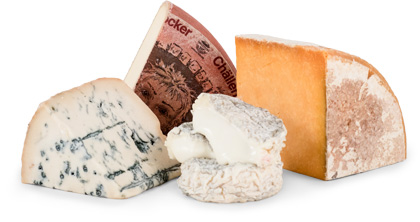The Italian Alps, the highest mountains in Europe, lie in the northwest corner of Italy, near the French and Swiss borders. They are terraced by the steep-sided pastures of Valle d'Aosta, over which towers Mont Blanc. In spite of the very dry summers, these high-altitude pastures provide a wonderful variety of lush, unique grasses upon which graze the cows whose milk gives us Fontina. Genuine Fontina is made only in Valle d'Aosta. It’s an ideal gustatory expression of this territory's inimitable character, its history, its hard-working people, and their love for the mountains. During the summer the cheese is made at the chalets in the alpine pastures, and in the winter months it’s made in creameries lower down in the valley.
Only fresh, raw (unpasteurized) milk from a single milking of Valdostana cows is used to make Fontina. The cheese is made twice every day, and aged for a minimum of three months in natural environments. Each cheesemaker has his own favorite location for ripening his cheeses: caves, grottos, tunnels, even former military bunkers. One cooperative dairy uses an old copper mine. Exotic, earthy, and enchanting, Fontina is perhaps one of the best Italian flavor experiences around. Sadly, most “Fontina” available in this country is a pale imitation of Fontina, but, happily, the cheese you are about to taste is the real thing!
It’s made in large, 17- to 22-pound wheels, about 4 inches thick, and 18 inches in diameter. Its flavor is due in part to the incredible richly flavored milk it is made from, a natural result of cows feeding on the wide range of grasses and plants on the hillsides of the Italian Alps: flora untouched by chemicals. Fontina is 45% fat and has a thin, creamy brown to terracotta rind that is lightly oiled and uneven. The cheese is smooth and buttery, almost spreadable, when young. It’s milky, and you can detect the smell of the alpine meadows. It has a pale straw color and a few small holes fairly evenly distributed throughout. As the cheese matures, it becomes darker and much drier. The older cheese develops an earthly but fruity aroma and a mellow flavor that’s both nutty and fruity.
Authentic Fontina Valle d'Aosta has a mark on it that you can’t miss. Stenciled in purple on one side of the cheese is a large circle with a mountain in the center of it with the word “Fontina” printed across the mountain. Look also for the name of the local cooperative stenciled on the rind of each authentic Fontina cheese.
Fontina is a wonderful cheese for cooking and is a great table or dessert cheese. It melts into a creamy mass that works well for sauces. Fonduta, the Piedmontese version of fondue, uses Fontina instead of the Swiss Gruyere and also butter, eggs, and wild mushrooms. (Fontina can also be substituted for Swiss Raclette.)
Fontal, an imitation of Fontina, is a second-class cheese. It’s produced in both France and Italy and the result is flavor that’s not consistent. Fontinella, Fontella, and Fontal are all brand names used by the big creameries of the Po Valley for their look-alike Fontina cheeses. They are often pleasant, but they are definitely not Italian Fontina!
Danish Fontina is a red-waxed cheese and is very bland and rubbery. Roth Kase Fontina comes from an American creamery in Monroe, Wisconsin, that uses a heat-treatment technique that does not capture all the flavor from the milk, but the cheese is good.
Fontina has enough flavors on its own to summarize the characteristics of the entire region of Italy called Valle d'Aosta. Fontina is dense, smooth, and slightly elastic. The straw-colored interior, with its small, round holes, has a delicate nuttiness with a hint of mild honey. This supple cheese's flavor hints of pristine forest floors, then shifts to a lovely yet powerful lingering scent of wild mushrooms.
The cheese is wonderful in Risotto. Actually, we would describe Fontina as a perfect anytime cheese that marries well with ham, salami, or pate. When melted, as it frequently is, the flavor is earthy and adds a depth of flavor to any dish that calls for cheese. Serve this cheese with celery or fruit, or use it for toasted or grilled sandwiches.

Experience International Variety
You might receive a Gaperon, originating in France during the 14th Century, an
authentic Lancashire by Ruth Kirkham, and an Italian Taleggio matured in the
caves of Valsassina…all in one shipment!

